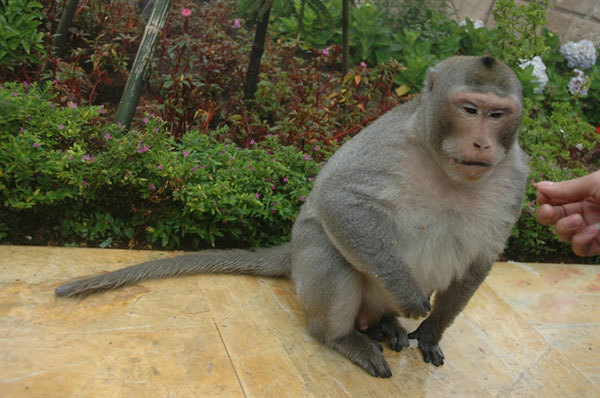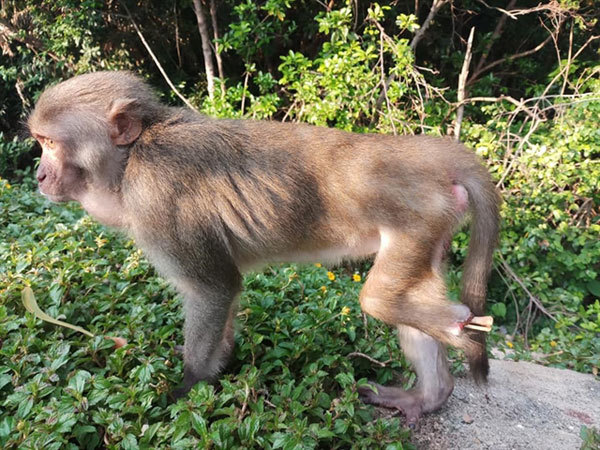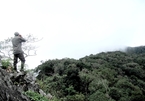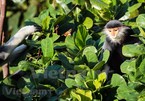 |
| A monkey is given food by a visitor at a destination in Da Nang. Son Tra District in Da Nang has launched a conservation project on the protection of monkey and primates in the Son Tra Nature Reserve. — Photo courtesy of Tran Huu Vy |
Director of GreenViet, Tran Huu Vy, said the research, which began last December, has been tracking the habitat and population of the monkeys as well as food chains to limit risks of conflict with human activities.
He said the research was urgent as many flocks of monkey had left their habitat in the primary forest to seek food from tourists and offerings at temples and pagodas at the foot of Son Tra mountain recently. Monkeys had conflicts with people when local residents and visitors tried to feed them.
Monkeys even broke into kitchens and fruit farms in the reserve, raising risks of transmitting viruses between the primates and people.
Despite serious warnings to not feed monkeys in the reserve, some local residents and tourists have given monkeys fruit, snacks and bread in the reserve.
Local rangers said they believed a group of 30 monkeys that used to gather by the Linh Ung Pagoda to seek food from visitors returned to their natural habitat during COVID-19 social distancing orders between April and July.
However, the monkeys reappeared at some destinations to get food from tourists during the Tet (Lunar New Year) holidays.
 |
| A monkey that has suffered a cut. Many monkeys have been injured or killed in conflicts with human activities in the Son Tra Nature reserve in Da Nang over past years. — Photo courtesy of Nguyen Cong Hung |
Vy, a biodiversity conservationist, said it was important to stop feeding monkeys at tourism sites and long-term research should be built-in with the conservation and protection of the monkeys.
Research by a group of conservationists from GreenViet and Da Nang University’s Science and Education College found there were about 50 herds of rhesus macaques with more than 500 individuals living in the reserve.
Biologists also warned that monkeys living in the reserve could break into resorts, causing trouble for tourists and management if local authorities do not have any effective solutions for the conservation and protection of the primates.
According to Son Tra-Ngu Hanh Son forest protection sub-department, some traffic accidents occurred in the area in recent years when cars and motorbikes hit monkeys crossing the road.
Last year, a baby monkey was grabbed by a local man at Linh Ung Pagoda, while two other monkeys were killed by household dogs at farms in the reserve.
At least eight rhesus monkeys were found living at the Linh Ung Pagoda with serious injuries or missing limbs, according to local freelance photographer Nguyen Cong Hung.
 |
| Kids join a painting session on wildlife and nature protection at GreenViet's Nature Dance Centre -- an education centre on nature and environment in Son Tra nature reserve of Da Nang. — VNS Photo Cong Thanh |
Six monkeys were killed by motorcyclists in 2015-17, and two cases of illegal hunting were uncovered in the area, with three red-shanked douc langurs killed for money.
The rhesus macaque is listed as Least Concern in the International Union for Conservation of Nature (IUCN)’s red list of threatened species.
The 4,400ha reserve is home to more than 1,300 red-shanked douc langurs – an endangered primate species listed by IUCN – and more than 1,000 plant and 370 animal species including 15 flora and 25 fauna species listed as the most threatened species in the world.
It hosts at least 10,000 people each month. VNS

Safe haven for endangered species
Covering an area of 137,124ha , or 14 per cent of the total area of the Central Highlands’ Kon Tum Province, Kon Plong forest is a rich biodiversity site with 118 species of flora and 137 of fauna.

‘Queen of primates’ through the lens
The red-shanked douc langurs, recognized as ‘queen’ of the primate species, have always been the inexhaustible inspiration of photography and wildlife lovers.